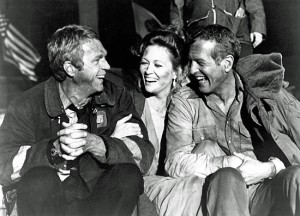Seeing Double Part 2: When Studios Collide
Why business enemies sometimes become partners
/https://tf-cmsv2-smithsonianmag-media.s3.amazonaws.com/filer/20120104020118titanic-thumb.jpg)
It’s been a less-than-stellar year for the film industry. Box-office receipts are down 4.5% from 2010, a decline that’s worse than it looks because of the inflated ticket prices for 3-D movies. While the industry will make slightly over $10 billion in North America, overall attendance dropped 5.3% (after falling 6% the year before). Executives have to be aware that the sales of the videogame Call of Duty: Modern Warfare 3 topped $400 million in a day. That’s more than Harry Potter and the Deathly Shadows Part 2—the year’s top earner and also the last installment in the franchise—made all year.
How will studios respond? Mostly by continuing what they’ve been doing before. The top seven (and if Mission: Impossible—Ghost Protocol and Sherlock Holmes: A Game of Shadows continue performing, make that the top nine) releases in 2011 were sequels. According to Ray Subers at Box Office Mojo, “There are at least 27 sequels, prequels or spin-offs already scheduled, which represents roughly 20 percent of the nationwide releases” for the 2012 calendar.
I’ll go more into upcoming releases next week, but for now I’d like to point out that sequels, remakes, and adaptations are an easy, if not especially creative, way for studios to protect themselves against fluctuating viewership. They don’t require as much development or publicity funding, and producers can make them relatively cheaply, apart from recalcitrant actors who keep demanding more money.
Another way to limit exposure and potential losses has become increasingly popular over the past four decades, and that is to share production costs with rival studios.
Studios executives were once bitter rivals, particularly in the early days of cinema. In 1908, Thomas Edison tried to put other moviemakers out of business by claiming that they were infringing on his patents. Troupes decamped for locations like Florida and California that were theoretically outside Edison’s reach. (Better weather was another significant factor.)
Producers routinely poached from each other. In 1910, Carl Laemmle, later to head Universal, lured Florence Lawrence from Biograph to his new IMP studio. Sigmund Lubin often duped films from Europe and even those made by the Edison studio and released them as his own. If that failed, he would peddle his own version of a story to theater owners, who could choose either an Edison or a Lubin Uncle Tom’s Cabin in 1903.
But as the industry matured, its leaders realized that some cooperation among studios would be necessary. Like athletes, performers and writers were signed to long-term contracts. Studios would farm out talent for individual projects, as MGM did with Clark Gable for Columbia’s It Happened One Night. And while titles couldn’t be copyrighted, they could be registered so competing films wouldn’t confuse customers. When he made Some Like It Hot, Billy Wilder had to clear the title with Paramount, which had released a Bob Hope comedy with the same name in 1939.
In some instances, a film franchise would switch from one studio to another. Charlie Chan appeared in almost 30 mysteries at Twentieth Century-Fox before the series moved to Monogram Pictures. Similarly, Tarzan went from MGM to RKO.
In some instances, even closer cooperation was required. Walt Disney struggled to get his cartoons into theaters. He relied on studios like Columbia, United Artists, and for several years RKO to distribute his pictures until establishing the Buena Vista subsidiary in 1955.
Some projects are just too risky for one studio to undertake. In these instances, two or more studios will align together to share costs. The most famous coproduction may be Gone With the Wind, released by Selznick International and MGM in 1939. Producer David O. Selznick was forced to let MGM distribute the film in order to obtain Clark Gable, under contract to the studio.
Other coproductions occurred when too much money had already been invested for one partner to pull out. Warner Bros. spent $390,000 on The Tower, a novel by Richard Martin Stern; while at Twentieth Century-Fox, producer Irwin Allen shelled out $400,000 for the similarly themed The Glass Inferno by Thomas N. Scortia and Frank M. Robinson. The two teamed forces for The Towering Inferno (1974), released in the United States by Fox and overseas by Warner Bros.
The studios switched roles for Ladyhawke (1985), a Richard Donner fantasy starring Matthew Broderick, Rutger Hauer and Michelle Pfeiffer, with Warners picking up domestic distribution and Fox assuming the overseas release.
Splitting release territories became a common tactic in coproductions. Paramount Pictures and Walt Disney Productions did it for Popeye in 1980 and again for Dragonslayer the following year, although Disney then formed Touchstone Pictures to handle its more mature fare.
The biggest coproduction in recent years is Titanic (1997), jointly released by Paramount (US) and Fox (overseas). The film was originally going to be distributed solely by Fox, until the budget started creeping over the $200 million mark. (A 3-D version of Titanic is scheduled to be released on April 6, 2012.)
Today, coproductions are routine. Take Warner Bros., for example. Of their 22 releases in 2004, 16 were coproductions. In 2009, only two of 18 releases were wholly financed by the studio. This season’s performance capture film The Adventures of Tintin was originally a joint production of Universal and Paramount, but the former dropped out early on in the development process and was replaced by Columbia Pictures.
/https://tf-cmsv2-smithsonianmag-media.s3.amazonaws.com/accounts/headshot/daniel-eagan-240.jpg)

/https://tf-cmsv2-smithsonianmag-media.s3.amazonaws.com/accounts/headshot/daniel-eagan-240.jpg)